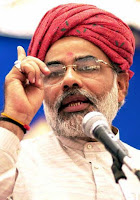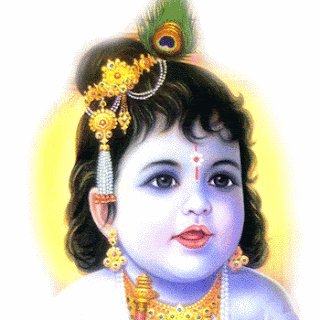Do you know Mr. Narendra Modi?
 Courtesy: "A loner, even at the top" by Prashant Dayal and Radha Sharma , TNN (Times of India)
Courtesy: "A loner, even at the top" by Prashant Dayal and Radha Sharma , TNN (Times of India)No one really knows the real Narendra Modi. The 57-year-old BJP leader prefers to remain solitary. He even dines alone. Only a handful of people are welcome to his residence. He seldom entertains guests. Apart from what is required to maintain high-level security, there are no trappings of power at his official residence: Bungalow No 26, Ministerial Enclave. Only three staffers - a cook and two peons - are posted there.
When the cook goes on leave, one of the peons prepares his meals. An early riser, Modi gets up around 5am. Among the first things, he surfs the net for news. The state information department delivers all the local newspapers at his doorstep. Rarely has anyone seen his family members at his residence. His mother Heeraba (95), who has lost her hearing, stays with her eldest son Soma (68) in the Ranip area of Ahmedabad. In October 2001 at the first swearing-in ceremony of Modi as chief minister, she stood alone in a corner watching her son on the stage.
That's when Modi confidante and state minister Anandi Patel spotted her and offered her a seat on the dais. Modi is the second among four brothers after Soma, who retired as an officer in the state's health department. He now manages an old-age home in Ahmedabad. The third, Prahlad (55), runs a fair price shop in the state capital. He is seen as a leader of fair price shop owners, frequently taking up their problems with the government. A year ago he led an agitation over bad quality goods supplied by the state and pilferage. Pankaj (50) is the youngest of the Modi brothers.
He works as a clerk in the information department in Gandhinagar. Most people did not know that he was the brother of an important politician till Modi became CM. The brothers grew up in Vadnagar, a small town about 100 km north of Ahmedabad, in Mehsana district. Modi was said to be an adventurous boy. The story goes that as a pre-teen he used to swim with friends in the Sharmistha lake which was infested with crocodiles. Once he caught a baby reptile and brought it home! Modi’s teachers and friends remember him as a boy who was cordial to his teachers but obstinate with fellow students. Prahlad Patel, who taught him in school, says, “Modi would never show his homework to the class monitor, only to the class teacher.” Modi was into oratory and drama early in life.
His friends and teachers still remember him for his powerful performances in two school plays: Hariyali no Hatyaro and Jogidas Khuman. Both plays were high on the patriotic quotient. Hariyali was set in the backdrop of the Indo-Pakistan war while the latter was based on the life of Khuman, a Kathiawadi rebel. Modi’s schoolmate Narendra Shastri recalls that the Gujarat CM was a star performer on stage during his childhood. “His theatrical skills are coming good in his political career,” he says. Some see in him shades of Morari Bapu, the wildly popular “kathavachak”.
The three-time Gujarat CM is an OBC. But Modi’s community Ghanchi forms less than one per cent of the state’s population. At the Vadnagar railway station in the early 1960s, he used to help his father, Damodardas, run a tea-stall. That experience helped him assist elder brother, Soma, in running a canteen at Gita Mandir bus station, Ahmedabad. Modi usually manned the cash counter. There, in 1966, he came in contact with a few Jan Sangh workers. The same day the teenager went to the local Jan Sangh office and offered to join the party. It is ironical that the teenager left politics within three months of joining the Jan Sangh. He thought himself to be a misfit in politics. Instead, he wanted to do social service.
The Parivaar didn’t want to let go of a promising teenager at a time when the RSS had only one shakha in Ahmedabad. Modi was taken to the RSS office at Hedgewar Bhavan in Maninagar where he used to stay and which now falls under his Vidhan Sabha constituency. Here, Sangh stalwarts like Nathalal Jhagada indoctrinated him. He developed a fixed way of looking at issues and people. Years later, he told a reporter that “ Maas khane wale logon ka vyavhar alag hota hai (Meat-eaters have a different temperament). He wasn’t referring to Muslims though, just his own party colleague Kashiram Rana.
Much earlier, Modi had told his RSS gurus that he had married as a child, a fact that could have come in the way of him becoming a pracharak. Modi keeps the marital status column blank while filling up forms. But it is well-known that a teacher named Jashodhaben in a Banaskantha school, is Modi’s child bride. She takes the CM for her husband even if she has never met him after the marriage. Jashodhaben never got married again. Sociologist Tridip Suhrud says that “celibacy is seen as the highest form of manhood.
This creates an aura around a person, seen in the case of Modi today.” Even old RSS hands say Modi is a loner. He used to read a lot of literature on Swami Vivekanand, Tilak, Golwalkar and he often challenged the views of his seniors. Due to his regular tussles with them, Modi often got shuttled during his tenure as a pracharak from 1974 to 1988. During the Emergency, he roamed the length and breadth of Gujarat on a motorcycle with the RSS prant pracharak Keshavrao Deshmukh, visiting families of RSS workers who were detained under the dreaded MISA. When Modi came into the BJP as the state’s organization secretary, he was seen as a high-flying pracharak used to the good things in life.
He travelled in cars and, when the BJP first came to power in Ahmedabad Municipal Corporation, he moved into a room on the first floor of the mayor’s bungalow at Law Garden. Later, when Modi moved to BJP’s Delhi HQ, he acquired a taste for expensive watches, pens and good clothes. Over the years, he has also crafted out a sartorial style of his own with a wardrobe of half-sleeve kurtas and tight churidars . It is said Modi spends hours on grooming sessions. During the Navratri, he visits eight-nine pandals every night. Clearly, the festival is brand-building time for him.
His recent politics, after the 2002 Gujarat killings in which over 2000 Muslims died, has been a shrewd mix of development, Gujarati asmita (identity) and communal views masking as war against terrorism. But understanding Modi, the politician, isn’t easy. RSS ideologue Vishnu Pandya says Modi has introduced pracharak Baba Saheb Apte’s concept “ Ek chalak nu varchasva (only an upright and a strong leader can deliver)” in politics. The middle-class is enamoured of him and in a recent article social scientist Ashis Nandy argues that Modi knows how to keep his core constituency captive through “rhetoric, fear and anxiety”. His legion of supporters seems to be growing.
The flood of congratulatory messages in cyber space shows he is undoubtedly Gujarat’s global man of the moment. There are many who feel Modi wouldn’t prosper in national politics because NDA allies will not be comfortable with him. However, Modi has shown a propensity for reinventing himself to suit the occasion.

Comments